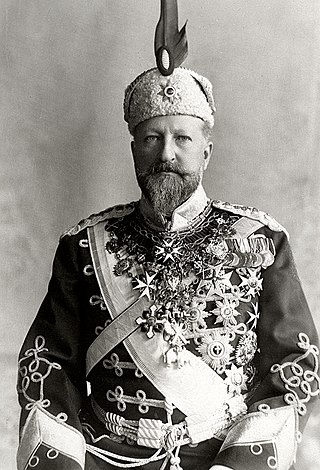
Ferdinand I was Prince of Bulgaria from 1887 to 1908 and Tsar of Bulgaria from 1908 until his abdication in 1918. Under his rule Bulgaria entered the First World War on the side of the Central Powers in 1915.

Tsar SimeonI the Great ruled over Bulgaria from 893 to 927, during the First Bulgarian Empire. Simeon's successful campaigns against the Byzantines, Magyars and Serbs led Bulgaria to its greatest territorial expansion ever, making it the most powerful state in contemporary Eastern and Southeast Europe. His reign was also a period of unmatched cultural prosperity and enlightenment later deemed the Golden Age of Bulgarian culture.

Knyaz, kniaz or knez is a historical Slavic title, used both as a royal and noble title in different times of history and different ancient Slavic lands. It is usually translated into English as prince or duke, depending on specific historical context and the potentially known Latin equivalents of the title for each bearer of the name. These translations probably derive from the fact that the title tsar was often treated as equivalent to "king" by European monarchs. In Latin sources the title is usually translated as princeps, but the word was originally derived from the common Germanic *kuningaz (king).
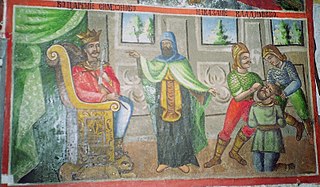
Vladimir-Rasate was the ruler of the First Bulgarian Empire from 889 to 893.
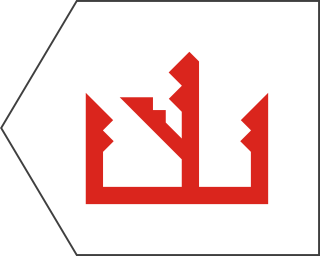
The Second Bulgarian Empire was a medieval Bulgarian state that existed between 1185 and 1396. A successor to the First Bulgarian Empire, it reached the peak of its power under Tsars Kaloyan and Ivan Asen II before gradually being conquered by the Ottomans in the early 15th century.

Mitso Asen, not Micho Asen, in Greek, Μύτζης, Mytzēs, was the tsar of Bulgaria from 1256 until 1257.
Michael or probably more fully Michael Asen II was an emperor (tsar) of Bulgaria, the son of Emperor Constantine Asen I of Bulgaria and his second wife Maria Palaiologina Kantakouzene, niece of the Byzantine emperor Michael VIII Palaiologos, being the daughter of his elder sister Irene Palaiologina by John Kantakouzenos. Michael reigned as sole emperor from 1277 to 1278, and claimed the throne again in 1302/3. As an ephemeral and underage monarch, Michael is often overlooked in listings of Bulgarian rulers.

The last Bulgarian royal family is a line of the Koháry branch of the House of Saxe-Coburg and Gotha, which ruled Bulgaria from 1887 to 1946. The last tsar, Simeon II, became Prime Minister of Bulgaria in 2001 and remained in office until 2005. Members of the royal family claim the titles of Prince (Princess) of Bulgaria and Duke (Duchess) in Saxony, with the style of Royal Highness.
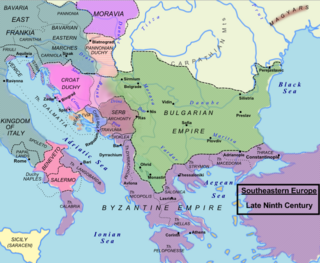
The Battle of Southern Buh occurred near the banks of the eponymous river. The result was a great Bulgarian victory which forced the Magyars of the Etelköz realm to abandon the steppes of southern Ukraine, as well as their aspirations of subduing Danube Bulgaria, retreating to the newly occupied lands beyond the Carpathian Mountains, centering on Pannonia, from where they will stage their next war, against Moravians this time, defeating them and establishing a new Hungary, after the Etelköz state in modern Ukraine, which succeeded an earlier stage of statehood for the Magyars, the legendary although short-lived Levedia, and even one before that, in the actual country of origin for the Magyars, Yugra, beyond river Ob.

The Bulgarian-Serbian wars were a series of conflicts between the Bulgarian Empire and medieval Serbian states between the 9th and 14th centuries in the central Balkans.
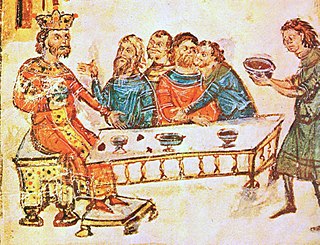
The medieval Bulgarian army was the primary military body of the First and the Second Bulgarian Empires, and some Puppet states of the former, like the Despotate of Dobruja. During the first decades after the foundation of the country, the army consisted of a Bulgar cavalry and a Slavic infantry. The core of the Bulgarian army was the heavy cavalry, which consisted of ca. 12,000 heavily armed riders. At its height in the 9th and 10th centuries, it was one of the most formidable military forces in Europe and was feared by its enemies. There are several documented cases of Byzantine commanders abandoning an invasion because of a reluctance to confront the Bulgarian army on its home territory.
Prince of Tarnovo is the title held by the first-born son of the Bulgarian monarch. This title is held only by the heir to the throne.
The People's Council of Preslav took place in 893. It was among the most important events in the history of the First Bulgarian Empire and was a cornerstone of the Christianization of Bulgaria under prince Boris I.
This is a list of people, places, and events related to the medieval Bulgarian Empires — the First Bulgarian Empire (681–1018), and the Second Bulgarian Empire (1185–1396).
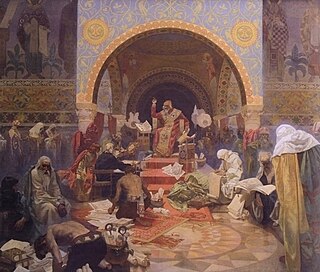
Tsar was a title used by Slavic monarchs. The term is derived from the Latin word caesar, which was intended to mean emperor in the European medieval sense of the term—a ruler with the same rank as a Roman emperor, holding it by the approval of another emperor or a supreme ecclesiastical official —but was usually considered by Western Europeans to be equivalent to "king". It lends its name to a system of government, tsarist autocracy or tsarism.
The Byzantine–Bulgarian war of 913–927 was fought between the Bulgarian Empire and the Byzantine Empire for more than a decade. Although the war was provoked by the Byzantine emperor Alexander's decision to discontinue paying an annual tribute to Bulgaria, the military and ideological initiative was held by Simeon I of Bulgaria, who demanded to be recognized as Tsar and made it clear that he aimed to conquer not only Constantinople but the rest of the Byzantine Empire, as well.
The Siege of Constantinople was fought in June 922 at the outskirts of the capital of the Byzantine Empire, Constantinople, between the forces of the First Bulgarian Empire and the Byzantines during the Byzantine–Bulgarian war of 913–927. In the summer the Byzantine Emperor Romanos I Lekapenos sent troops under the commander Saktikios to repel another Bulgarian raid at the outskirts of the Byzantine capital. The Byzantines stormed the Bulgarian camp but were defeated when they confronted the main Bulgarian forces. During his flight from the battlefield Saktikios was mortally wounded and died the following night.
Leontius was the first Patriarch of the Bulgarian Orthodox Church. Very little is known of his life and tenure. He was mentioned as the first Patriarch of Bulgaria in the Book of Boril, written in 1211.
Maria was a Bulgarian royal consort as the wife of the Knyaz Boris I of Bulgaria. Her parents are unknown. She is mentioned in one charter from 850/96, together with her family members.














